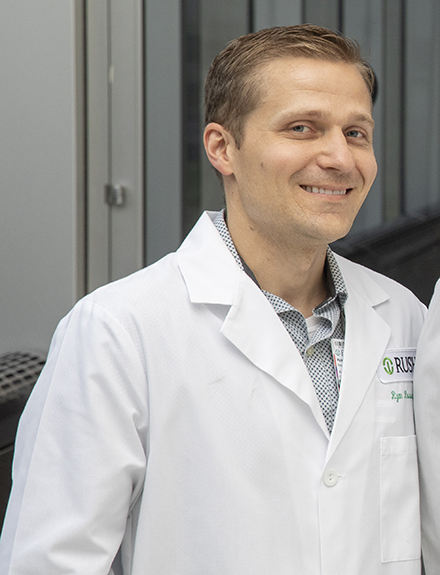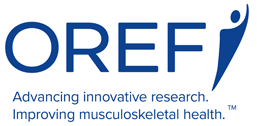

Ryan D. Ross, PhD
Orthopaedic Research Society (ORS)/OREF Post-Doctoral Fellowship Grant
Research Topic
Evaluated biomarkers as predictors of osteolysis
Patient Impact
Osteolysis can be diagnosed early in the disease progression rather than late in the process when there may be significant bone loss, which gives patients better treatment options
Shifting the Diagnostic Timetable
OREF grant recipient searches for osteolysis biomarkers
Jay D. Lenn, OREF contributing writer
By 2030, more than 4 million patients will need a primary joint replacement.1 Revision joint replacement surgeries are also expected to climb by 2030 to more than 350,000.1 Aseptic loosening, one of the leading contributors to implant failure and the subsequent need for revision surgeries, can be caused by wear particles or other debris from joint implants that induce osteolysis—bone resorption and suppressed bone formation. Because the pathology begins long before diagnosis, revision surgery is often complicated by significant bone loss, as well as common age-related, comorbid conditions that can affect surgical outcomes.
“Osteolysis is very much a silent disease,” explained Ryan D. Ross, PhD, assistant professor of cell and molecular medicine at Rush Medical College. “It progresses in the background without much evidence. The patient doesn’t present with pain when it begins. There’s no radiographic evidence that it’s occurring. It starts much earlier than when it’s diagnosed.”
The ability to diagnose osteolysis earlier would provide surgeons with the opportunity to perform revision surgery while the patient still has adequate bone mass, or possibly to offer alternative treatment that avoids the need for a revision altogether. Dr. Ross and his colleagues have investigated disease biomarkers that may move the diagnostic timetable forward and enable earlier intervention.
Searching for biomarkers
Dr. Ross’s investigation was initially supported during his fellowship at Rush University Medical Center with a 2015 Orthopaedic Research Society/Orthopaedic Research and Education Foundation (ORS/OREF) Post-Doctoral Fellowship Grant. The one-year, $50,000 grant supports an emerging clinician-scientist or basic science researcher collaborating with a clinical orthopaedic team.
The investigation of disease biomarkers grew from research led by Dr. Ross’ mentor, D. Rick Sumner, PhD, whose team had developed a rat model of osteolysis to investigate pharmaceutical treatments that enable intervention prior to implant loosening.
One barrier to developing such interventions—translating what seems promising in animal models to clinical investigations—is the silence of the disease. It is difficult to develop clinical trials because there’s no reliable means to determine who is at risk for joint loosening. Additionally, a valid biomarker should not only determine the need for treatment, but also serve as an objective measure of treatment effect.
Because the rat model for investigating treatment was a well-understood, homogeneous population, it provided data about which markers were the most promising for determining patients’ risk for periprosthetic joint loosening. Dr. Ross stated, “We know when the disease started in these animals, how long it had progressed, how much bone was lost, and how loose the implant was. We wanted to see which markers indicated a progression to bone loss and whether they provided evidence of osteolysis before we actually observed implant loosening.”
Transitioning to clinical research
The ORS/OREF grant funded Dr. Ross’ investigation in a clinical population of the candidate markers identified in the rat model. This work was possible because of follow-up records, radiographs, and banked 24-hour urine samples from patients who had undergone total hip replacement at Rush University Medical Center. This collaboration with Joshua J. Jacobs, MD, provided longitudinal information up to 18 years.
“The first step, believe it or not,” said Dr. Ross, “the practicality of it all, was going through the multitude of freezers to track down patient samples that were initiated in the mid-1980s. A lot of these samples are about as old as I am.”
Based on the animal model research, Dr. Ross’ group selected five biomarkers of bone remodeling and two markers of inflammation that are stable in urine. The researchers used the clinical data from 16 patients who had radiographic evidence of osteolysis and 10 who never developed it. They measured concentrations of biomarkers before surgery; at three, six, and 12 months after surgery; and annually thereafter.
The investigators evaluated biomarkers alone and in combination for their diagnostic accuracy, specificity, and sensitivity, as well as the earliest time point at which they were able to differentiate the two patient populations.
Identifying markers and unexpected outcomes
Findings from the research of Dr. Ross and his colleagues were published online in June 2018 by the Journal of Orthopaedic Research.2 The researchers observed that a panel of the bone-remodeling biomarker α-CTX and the inflammatory marker IL-6 most accurately predicted the risk of osteolysis post-operatively.
Unexpectedly, the investigators also found that the pre-operative levels of these two biomarkers were the most accurate predictors of risk—more accurate than concentrations at any post-surgery time point. The researchers surmised that individual patient factors, such as genetics, may increase the risk of osteolysis.
Additional large-scale research is needed to validate these findings and test the clinical utility of these biomarkers for diagnosis and treatment monitoring. Dr. Ross is currently working with Dr. Craig Della Valle and his research team, chiefly Anne DeBenedetti, at Midwest Orthopedics at Rush to recruit patients into a new biorepository to follow-up on these findings. “We hope to validate our previous findings in this new patient population and to drill further into the mechanisms that contribute to the risk of osteolysis.”
Making the most of grants
Dr. Ross noted that the value of the ORS/OREF grant extended beyond the monetary support. He stated, “An advantage of having a grant is that it gives you the opportunity to really compile your thoughts—get your experimental plan together in a very cohesive manner. And then you get feedback from experts in the field who can tell you if your idea and plan make sense to somebody who’s not intimately involved in it.”
He also noted the importance of the grant application process in professional and career development. He described the importance of writing applications, learning practical budgeting skills, and conducting research in a financially responsible way. Dr. Ross stated, “It’s becoming very important in job searches, as funding becomes tight, because universities want someone—almost a bankable asset—who knows how to get their own funding. It’s less risky for them to have people who really know what it takes to manage and fund a project.”
References
1. Kurtz, S., Ong, K., Lau, E., Mowat, F. & Halpern, M. Projections of primary and revision hip and knee arthroplasty in the United States from 2005 to 2030. J.Bone Joint Surg.Am. 89, 780-785 (2007)
2. Ross, R. D., Deng, Y., Fang, R., Frisch, N. B., Jacobs, J. J. and Sumner, D. R. (2018), Discovery of biomarkers to identify peri‐implant osteolysis before radiographic diagnosis. J. Orthop. Res., 36: 2754-2761. doi:10.1002/jor.24044
